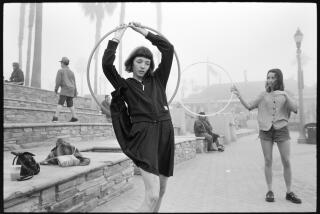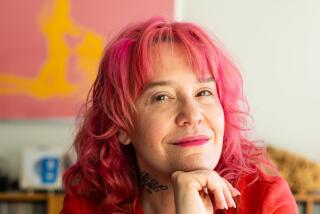It’s in His Blood : J. Gordon Melton, Author and Minister, Has Long Been Fascinated With . . . Vampires
- Share via
Any day J. Gordon Melton reports for work, California’s off-kilter image is in capable hands. People who know the state well could argue that Melton, a writer and editor for Gale publishing company, isn’t inventing anything. He’s just keeping track of what goes on all around him. Given his interests, that includes new religions, old cults and a fascination with vampires.
Why a pumpkin-head Dracula with bat wings would lounge on a stack of library reference books written by Melton is not an easy question to answer. It goes back to his life as a researcher of religion and a teenage infatuation with the Count.
Sometimes the two cross wires. Melton’s seriously silly “The Vampire Gallery: A Who’s Who of the Undead,” second edition, arrived in stores this month. It is filled with the dirt on recent vampire trials, facts about vampire trading cards, a travel guide of vampire cities, including New Orleans, profiles of famous names associated with Dracula, from Theda Bara to Bela Lugosi, and enough gory photographs to fill a bat cave.
Next month, Melton puts on his other hat to promote the weighty, academic “Encyclopedia of American Religions,” now in its sixth revised edition, also from Gale.
At his Institute for the Study of American Religion, a cubbyhole office in Santa Barbara, shelves bend under the heft of nearly 200 titles Melton has developed for Gale, if not written and edited. His “Religious Leaders in America,” second edition, is on his computer screen now.
Toward the far end of the shelves, though, the titles start slipping out of bounds. There is the “Encyclopedia of Cults in America” and the “Encyclopedia of Occultism and Parapsychology,” for example. It’s a mere tango twist from there to “The Vampire Gallery,” also new from Melton and Gale this fall, in which the most prominent vampires in history are profiled, along with listings of vampire clubs, authors and movie directors, and tidbits such as this: The first screen actor to sink his fangs into his victim was Count Lavud, not Bela Lugosi.
*
Collectors might already own last year’s tome from Melton, “Vampires on Video,” with capsule accounts of several hundred vampire-related horror movies and mini-profiles of the most bizarre and tortured of those involved in vampire flicks.
It would be easy to confuse an interest in religion at the fringes and a fascination with Count Dracula. But Melton keeps the two worlds separate. Transylvania’s famous royal is just a scary fantasy, some of the other stuff he studies is a scary reality.
“Religion and vampires do connect at one point,” he says. “Specifically, new religions.” These religions can take on a cultlike status similar to vampirism, with misinformation on both running rampant. By “new religions” he means those that existed elsewhere but only recently took root in this country.
“Over the years, I’ve wanted to do solid, accurate research on these new groups because they are so easy to attack,” Melton says. “The same is true about vampires. A lot of the books I’ve seen are filled with wrong information.”
Dracula gets confused with Satan, for example. The fact is, the Count had only one “interaction” with the devil, says Melton. He’s not a monster either. “Dracula’s the only one who can live among us incognito,” says Melton. Besides that, he’s immortal.
It’s not the usual thing for a man of the cloth to be mesmerized by a symbol of sinister evil. Melton is a minister in the United Methodist Church, though his black suit pants are the only hint of it.
He has been fascinated with Dracula from the time he started reading vampire comic books. Now in his 50s, long since departed from his home state of Alabama, Melton keeps a hint of the South in his accent. When he talks of vampires, this gentle sound can lull a person toward something like sympathy for the suave outlaw who fascinates the soft-spoken minister.
His big book, “American Religions,” has been a staple in college libraries for 15 years. He revises it every four years, and the overall picture changes so quickly that Gale refers to older editions as obsolete. The new one covers everything from Roman Catholic and Southern Baptist, the two largest denominations in the country, to the Church of Satan, one of the smallest, with a headquarters not far from Melton’s office.
“The most obvious change in the past four years is the rise of Buddhism in this country,” he says. “L.A. is the only place in the world where you find the whole spectrum of Buddhists, from Sri Lanka to Japan. It doesn’t exist in Asia.”
There are about 2 million Buddhists in the country, and 40% of them live in Southern California.
*
Muslims are a similar story. Melton estimates around 3 million in the U.S. and about 40% based here. Changes in U.S. immigration laws in 1965 and 1989 opened the way for the increased numbers. “California is home to so much religious ferment because it is a major landing port for immigrants,” he says.
Melton’s latest efforts have been to make greater order out of what can seem like the chaos of pluralism. “Ten years ago scholars were immersed in the idea of radical pluralism,” he says. “As it turns out, the scene isn’t as diversified as it looks, worldwide,” he says. He divides the country’s 2,000 denominations into 25 religious “families” made up of smaller groups. These families have “surnames” such as Lutheran, Eastern Orthodox, Anglican, Pentecostal and “non-Christian,” the term scholars traditionally use for the major Asian religions.
Air travel and the Internet are helping create a one-world culture. They’re also creating a world where the same religions are being practiced everywhere. “You might see that the dominant religion changes from place to place, but they’re all there, in every major city,” he says.
While world religions such as Buddhism and Islam got a strong start in California, a number of the fringe movements to make front-page news in recent years did too. “For all the violence and craziness that’s come from here, the rest of the world sees California as the home to almost anything,” he says.
Melton still keeps track of the fringe movements.
When Count Dracula slips back into conversation, as he has tended to do all afternoon, Melton owns up to a collection of more than 3,000 books and comic books. And then there are the trading cards, posters, games.
“I got into it as escapism, but there is more to it,” he says. “The myth of the vampire deals with questions about our idea of heroes. Dracula has power, sexuality, immortality. But we ask ourselves, ‘How would we deal with that if we had it? What would we do with our time? What if we didn’t eat or sleep?’ ”
Dracula starts to sound like a philosophy.
More to Read
Sign up for our Book Club newsletter
Get the latest news, events and more from the Los Angeles Times Book Club, and help us get L.A. reading and talking.
You may occasionally receive promotional content from the Los Angeles Times.










